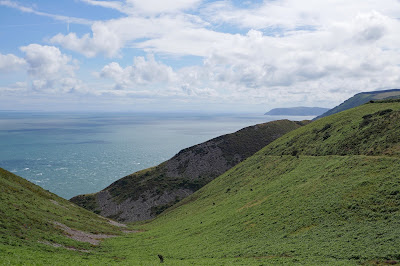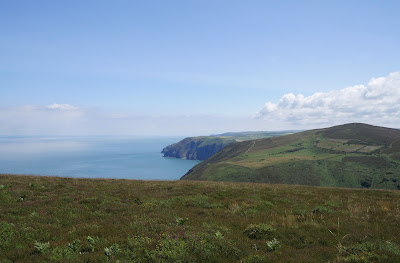Friday 14 July 2017
101 Lynton to County Gate
We set out from our hotel in Lynton and, perhaps controversially, took the wonderful funicular down to Lynmouth.
The funicular is water-operated, 862 feet (263 m) long, operating on a 1 in 1.75 gradient track. One car descends, while the other ascends, on a counterbalance system. The water is piped from the West Lyn River. It was opened in 1890 (information from Wikipedia).
We walked past the small harbour with its lovely Rhenish tower.
Soon the path took us into woodland to begin the long climb out of the town. After some zig-zags the path emerges onto the cliff side just below the road and the ascent continues, offering fine views over Sillery Sands.
Just before you reach the church of St John the Baptist at Countisbury (an 18th-19th century rebuilding of an older church) there is a great view of the shoreline of Sillery Sands.
The church enjoys a wonderful position.
The path levels out for a while as you walk above the grey sand beach. Then you start climbing again to pass just under the summit of Butter Hill (302m) where there are some lovely views back to Lynmouth/Lynton.
Now there is a bit a descent and then the path winds inland behind the great bulk of Foreland Point. There are great views down Caddaw Combe towards South Wales.
We followed the path on the right and then descended to the bottom of the valley and climbed again behind the coastal cliffs.
At the top we can see east as far as Hurlstone Point.
Once we entered the next zone - Glenthorne Cliffs - there was a fine view back towards Foreland Point.
The path which continued through Glenthorne Cliffs was predominantly woody with the path winding along a mid-cliff level around a series of combes. Just before Wingate Combe, we passed the worryingly named, but unimpressive, Desolation Point, photographed into the sun unfortunately.
After this, the path continued on the same line but now with the slopes mainly covered in rhodendrons. At length we emerged through a rather wonderful gate (note the pigs on the top) and realised that we had been walking through the grounds of Glenthorne House.
I haven't been able to discover much about this mysterious house except that it is Neo-Tudor house built 1829-30 for the Reverend Walter Stevenson Halliday. I would love to know the story behind the pigs' heads.
We headed uphill through woodland to pass this intriguing cross.
From here, a grassy track led uphill to the A39 and the boundary between Devon and Somerset. The County Gate car park is off to the right.
Conditions: Warm and sunny.
Distance: 6.2 miles.
Map: Explorer OL 9 (Exmoor).
Grading: Moderate to Strenuous.
Rating: four and a half stars. Dramatic at first. The area around Foreland Point was wonderful. A bit more mundane later, but always enjoyable.
Thursday 13 July 2017
100 Hunter's Inn to Lynton
The Hunter's Inn
We set out from the Hunter's Inn and re-traced the last part of yesterday's walk before resuming the Coast Path at the bottom of the Heddon Valley. Soon we came to the stone bridge over the River Heddon and began the long climb up the other side of the valley.
As we approached Heddon Mouth, there was a great view down to it.
At the top we passed inland of Highveer Point and had our forst view of the next section of coast, bounded by Foreland Point in the distance. Lynmouth and Lynton lie in the bay before it.
As we advanced, we noticed this interesting holed rock.
Now we were forced inland and were delighted to come on this waterfall.
The next section was through woods, but eventually a nice view across Woody Bay presented itself.
We joined a tarmac track inland through the small settlement of Woody Bay and left it at this rather wonderful sign, now heading towards New Zealand!
Soon there was a choice between a road option and a track option. Naturally, we took the latter and headed down towards the coast again. It was surprising how overgrown the field path was. After a while we began to glimpse this watch tower on the hill over Crock Point and eventually managed a half-decent pic of it.
We descended into the hamlet of Lee and enjoyed refreshments at the delightful cafe in its lovely garden. The route continued up the hill and past Lee Abbey, a Christian community, not an actual abbey.
The site was originally owned by the Cistercians at Forde Abbey and seems to have been rebuilt or extended in Victorian times. In the 1920s it became a hotel, at which time the main extensions were built. During the Second World War it became a boys' school, and in 1945 was acquired by the Christian Fellowship.
Just as you leave the Abbey grounds you enter the extraordinary Valley of Rocks. There is a curving rocky slope on the landward side, parallel to the sea and two very dramatic rocks on the seaward side. The OS map names them as Castle Rock and Rugged Jack, which seems pretty reaonable.
The far side of Castle Rock has some vaguely human or animal shapes: the one on the right suggested a Teenage Ninja Turtle to me.
Rugged Jack was truly impressive - note the small figures on the left hand side.
Now we followed the tarmac path which leads to Lynton for about a mile. It clearly offered a delightful excursion from the town. There was some evidence of goats on the path and just towards the end we discovered one of the culprits.
We were staying in a hotel right on the path so the walk ended soon afterwards.
Conditions: Warm and sunny.
Distance: 7.3 miles.
Map: Explorer OL 9 (Exmoor).
Grading: Strenuous.
Rating: four stars. Started and finished really well, but the section around Woody Bay was less enjoyable.
Wednesday 12 July 2017
99 Combe Martin to Hunter's Inn
The Little Hangman and Hangman Point
Five more stages to go! We set off from Combe Martin and began the long climb which continues to the Great Hangman. Immediately, we saw our first Gatekeeper of the year, appropriately enough by a gate.
As we passed inland of the Little Hangman (not so little at 218m) we enjoyed lovely views back to the west across Combe Martin Bay towards Watermouth Castle and Burrow Nose.
And a bit further along, a few houses in Combe Martin became visible as well.
Now the Great Hangman lay ahead.
We were surprised to see a fox wandering along the track ahead of us, but it soon got wind of us and hurried off.
As the climb continued, the views back became ever more wonderful.
And eventually we reached the simple, but rather large cairn which marks the summit at 318m. This makes it not only the highest point on the South West Coast Path, but the highest sea cliff in the whole country.
The path down looked straightforward, but we soon realised that we were being forced a long way inland to be able to cross the steep and very deep Sherrycombe. We descended steadily on a diagonal line towards the bottom of the combe and then climbed up the other side towards a plateau at about 260m.
On the way down we began to see some large fritillaries and I was pleased to get a good shot of a Dark Green Fritillary on a thistle on the way up. Another first of the year.
Later we hit a stony section and were rewarded by the sighting of several Graylings, the third first. There has also been lots of Meadow Browns and Ringlets and a smattering of others.
We were now on a classic level path two-thirds or more up the cliffside.
We continued alon g in this way towards the imaginatively named High Cliff.
As we approached Heddon Mouth it was fascinating to see a sudden change in the cliff - it became a great deal more rocky. But at least we could continue on the level high path.
Suddenly we turned a corner and the Heddon Valley stretched out in front of us as we looked into the sun.
The high path gradually descended towards the valley bottom and the River Heddon.
At the bottom we followed the track down to the lovely Hunters Inn where we were staying.
Conditions: Warm and sunny.
Distance: 7.3 miles.
Map: Explorer OL 9 (Exmoor).
Grading: Strenuous.
Rating: five stars. A wonderful section
Subscribe to:
Posts (Atom)












































